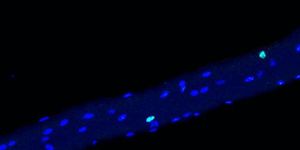Potential Treatment for Common Cause of Heart Disease is ID'ed
The most common cause of heart disease in elderly people is calcific aortic valve disease, in which calcium builds up in the valves and vessels of the heart, causing them to harden over time. As it happens, the blood flow out of the heart is obstructed and the heart eventually fails. There are few treatment options; patients must wait for the vessels or valves to be so hard that they can be replaced. Reporting in Science, researchers may now have a potential therapeutic.
"The disease is often diagnosed at an early stage and calcification of the heart valves worsens over the patient's lifetime as they age," said study leader, Gladstone President and Director of the Roddenberry Stem Cell Center Deepak Srivastava, M.D. "If we could intervene early in life with an effective drug, we could potentially prevent the disease from occurring. By simply slowing the progression and shifting the age of people who require interventions by five or ten years, we could avoid tens of thousands of surgical valve replacements every year."
About one or two percent of Americans have a congenital heart defect called a bicuspid aortic valve (in which there are only two instead of the normal three leaflets on the aortic valve), and many carriers will not know until their forties or later. "About a third of patients with bicuspid aortic valve, which is a very large number, will develop enough calcification to require an intervention," explained Srivastava.
Previous work has shown that mutations in a gene called NOTCH1 cause about four percent of cases of calcific aortic valve disease, while the rest are sporadic - there is no known genetic cause.
"The NOTCH1 mutation provided a foothold for us to figure out what goes wrong in this common disease, but most people won't have that mutation," noted Srivastava. "However, we found that the process that leads to the calcification of the valve is mostly the same whether individuals have the mutation or not. The valve cells get confused and start thinking they're bone cells, so they start laying down calcium and that leads to hardening and narrowing of the valves."
The researchers wanted to find a treatment that could work for patients with NOTCH1 mutations as wells patient with sporadic cases of the disease, so they began by searching for genes whose expression changes in diseased cells. These genes were then placed in a network using computational tools. Next, the scientists assessed the impact of about 1,600 drugs on this network. They found a few that could shift the disease network back toward a healthy state.
The candidate molecules were tested on cell lines derived from 20 patients with sporadic cases of aortic valve calcification. They found one that worked not only against these cases, but also against cases involving NOTCH1 mutations.
The researchers confirmed that the drug was effective in preventing and treating aortic valve disease in a mouse model; it could prevent the disease before onset, halt disease progression in ongoing cases, and sometimes even reversed it. Most human patients are diagnosed after the disease is already calcifying structures, so this work may be especially useful.
"Our strategy to identify gene network-correcting therapies that treat the core disease mechanism may represent a compelling path for drug discovery in a range of other human diseases," said lead study author Christina V. Theodoris, MD, PhD. "Many therapeutics found in the lab don't translate well to humans or focus only on a specific symptom. We hope our approach can offer a new direction that could increase the likelihood of candidate therapies being effective in patients."
Sources: AAAS/Eurekalert! via Gladstone Institutes, Science









